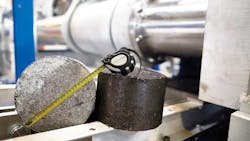Briquetting Fine-Particle Residual Materials
ATM RECYCLING SYSTEMS GmbH develops briquetting systems for processing scale, swarf, and other metallic residues, and now reports it is possible to form stable briquettes out of aluminous powder without the use of binders.
Landfilling is an expensive fix for many “waste” materials in foundries, and other plants producing metal parts. Frequently, those materials include fine-particle and contaminated residual materials, which have a high level of metal content, but are disposed at some considerable expense due to their physical and chemical properties. A developer of metal recycling systems has developed a process for conditioning the waste materials so that contaminated or toxic contents can be separated and the surface-to-volume ratio of the remaining material can be repurposed.
Specifically, the resulting material can be repurposed in the melting process to recover the valuable metallic content – a step toward “circular economics,” the emerging principle the aims for “zero-waste” manufacturing.
Briquetting improves the effectiveness of charging the material into a melting furnace and minimizes the dust exposure during the process. And, it added, the surface-to-volume ratio of the charge material is reduced – leading to an increase in metal yield.
Briquetting is suitable for a number of fine-particle residual materials, including swarf, trimmings and grindings from cast steel, aluminum, magnesium, brass, copper, bronze and titanium. Waste materials from other sources (furnace and ladle slag, battery waste, tire wire, and mill scale) can be used in powder form.
Grinding sludge, oils, and fluids can also be recovered using the briquetting process.
For over a decade ATM has been working with the department of nonferrous metallurgy at Germany’s University of Leoben to develop ways to process metalliferous residual materials. Its Arno®Brik briquetting presses produce compacted units that melt easily and safely, compared to loose swarf.
The presses are available with three different filling variants, to suit the material free-flow properties. An inclined feeder or a two-step feeder allow processing of both slurry and swarf.
The solid welded design with two or three columns makes the machines suitable for heavy continuous operation, and each machine can be operated manually or automatically.
All process sequences are visualized on a graphic operator panel and can easily be integrated into fully automated production lines. Remote maintenance and system adjustments can be carried out, too.
Learn more at www.atm-recyclingsystems.com
